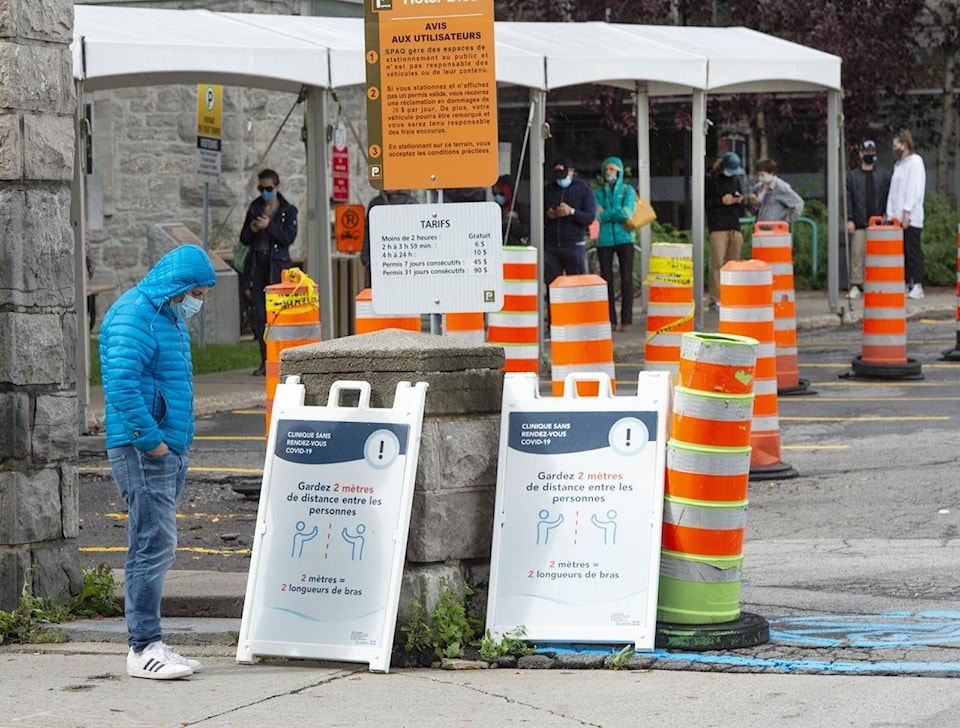MONTREAL — The second wave of COVID-19 infections in Quebec is already looking “very different” from the first, provincial Health Minister Christian Dube said Tuesday.
The provincial government reported 1,364 new confirmed cases on Tuesday morning – the highest daily total since the beginning of the pandemic. There have now been 81,014 cases of the novel coronavirus confirmed in Quebec, more than half of all cases in Canada.
While the first wave was marked by serious outbreaks in long-term care centres, there was limited community transmission outside of those facilities, Dube told reporters at an afternoon press conference. “This time, this is totally different,” Dube said, noting there are currently more than 500 active outbreaks across the province.
But Dube said the government doesn’t know how the virus is spreading through the community.
“It’s really hard to say, when you have a student being diagnosed at school, where he got it. Did he get it from his parent? Did he get it from his friend? From an uncle who got it at work? It is very difficult to know exactly where you got it,” he said. “That’s the reason we are saying right now, we are shutting down all those places where we can get together, because we don’t know exactly.”
Schools remain open in the province, but on Monday the government announced high school students in maximum-alert regions will be required to wear masks in class and those in Grades 10 and 11 will spend one day out of every two at home.
As of Oct. 2, the most recent date for which data is available, 666 schools had active cases of COVID-19 among staff or students.
Restaurant dining rooms, bars, theatres and other venues were shut in the so-called red zones, including greater Montreal and Quebec City, on Oct. 1 for a period of four weeks.
The Health Department reported three deaths in the previous 24 hours on Tuesday and said 14 earlier deaths have been linked to the novel coronavirus. Two deaths previously attributed to the disease were determined to have been from other causes, leaving the provincial death toll at 5,899.
There are now 397 people in hospital, an increase of 36 from the previous day, while 67 people are in intensive care — an increase of five.
But while the number of new cases is now higher than at any other point in the pandemic, the number of hospitalizations remains lower than during its previous peak. Throughout most of April, there was an average of more than 100 hospitalizations a day.
Part of that may be due to the fact that younger people, who are less likely to have severe symptoms, are now getting the disease, said Ashleigh Tuite, an epidemiology professor at the University of Toronto’s Dalla Lana School of Public Health.
But it’s also likely that the number COVID-19 cases in the spring were underestimated.
“Comparing the number of positive cases this month to the number of positive cases in April, isn’t a fair comparison, because we’re just doing more tests in the population,” she said.
On average, Quebec is now conducting more than three times as many tests as in April and more than twice as many as in May.
“There’s no such thing as one measurement that tells us everything we need to know,” said Dr. Matthew Oughton, an infectious disease specialist at Montreal’s Jewish General Hospital.
One important factor, he said, is the percentage of tests that are positive. The higher that number, the more likely the disease is widespread in the community.
“We usually consider anything less that one per cent to be indicative of good control. In the middle of August, we were at around half a percent,” Oughton said. “Whereas, from these numbers today, we’re at six per cent provincially.”
That figure could be even higher in hard-hit areas of the province, he said. While the provincial government releases data on the number of new cases by region, it doesn’t do that for testing.
As the number of cases grows in the community, there’s a greater chance that the disease will once again spread to a high-risk community, which could lead to a sudden rise in the number of severe cases, Oughton said.
This report by The Canadian Press was first published Oct. 6, 2020
———
This story was produced with the financial assistance of the Facebook and Canadian Press News Fellowship.
Jacob Serebrin, The Canadian Press
